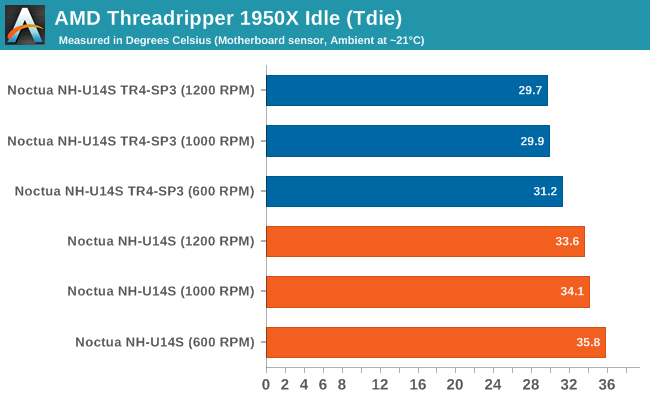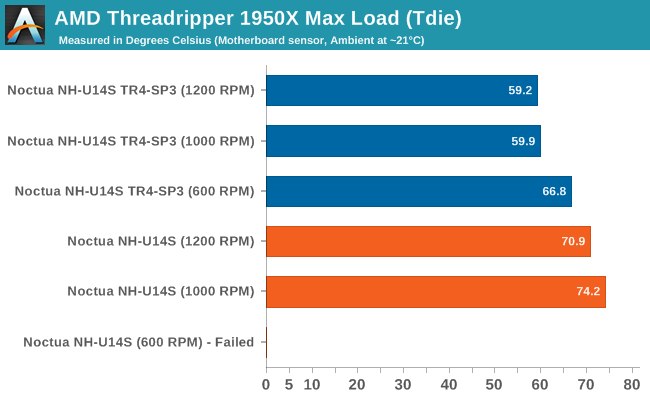Analyzing Threadripper Thermals: Big Base Cooling Wins
by E. Fylladitakis on March 14, 2018 8:30 AM EST- Posted in
- CPUs
- AMD
- Cases/Cooling/PSUs
- Noctua
- ThreadRipper
- 1950X
- CPU cooler
Test Methodology
Our test system appears in the following table:
| Test Setup | |
| Processor | AMD Threadripper 1950X 16 Cores, 32 Threads, 3.4 GHz |
| Motherboards | Gigabyte X399 Designare EX |
| Cooling | Noctua NH-U14S / NH-U14S TR4-SP3 |
| Power Supply | Corsair AX1200i Platinum PSU |
| Memory | Corsair Vengeance LPX 4 × 8GB kit |
| Memory Settings | 2666 MHz |
| Video Cards | MSI GTX 770 Lightning 2GB (1150/1202 Boost) |
| Hard Drive | Crucial MX200 1TB |
| Case | Open Test Bed |
| Operating System | Windows 10 64-bit |
For both tests, we used Noctua NT-H1 thermal grease on the processor. For the thermal grease to settle in, the processor was loaded for at least an hour, left to rest for at least two hours, loaded again, then left to rest overnight. The results were recorded on the next day. After the first tests, the CPU was thoroughly cleaned and the process was repeated for the second cooler.
By default, the motherboard is trying to control the speed of the cooler’s fans depending on the processor’s temperature, creating a variable environment. As we are trying to showcase what the difference between full and partial contact for the exact same cooling arrangement, we needed a stable environment, i.e. the fans had to be running at the exact same speed. Therefore, we are powering the fans from an external power source, maintaining stable RPM throughout our testing.
Finally, we are always monitoring and recording the Tdie temperature. That is a more accurate representation of the CPU's actual thermal state, as the Threadripper (and some Ryzen) cores report their operational temperatures with a large positive offset (+27°C) for control purposes.
Results
Starting off with idle temperatures, we're already seeing a difference between the two coolers. At all fan speeds, the larger-based TR4 model cooler is around 4C cooler than its standard counterpart. Given just how little power a Threadripper processor actually uses at idle, this is an interesting prelude of things to come.

Meanwhile under load, not only there is a clear difference on the performance of the two CPU/Cooler arrangements, but that difference is much more than merely significant. The figures that we recorded correspond to a major cooling upgrade. The standard NH-U14S can barely maintain our Threadripper 1950X functional under load, with the system throttling very heavily at all times.

With its fan's speed lowered down to 600 RPM, the NH-U14S could not handle the thermal load (hence the missing data point in the graph). Meanwhile although it is essentially the same cooler, the NH-U14S TR4-SP3 manages to maintain operational temperatures throughout all our tests, with no thermal throttling even with its fan's speed lowered down to 600 RPM. If we were examining two different coolers, such an improvement would easily differentiate a basic from an advanced air cooler. In our case, the two coolers are identical, yet the difference of the arrangement’s thermal conductance is substantial, all because of the cooler’s contact plate.
The following figure displays the CPU’s temperature over time with a script loading and unloading the processor every 10 seconds. The fans are running steady at 1200 RPM. It can be seen that the NH-U14S TR4-SP3 offers both better thermal performance than the standard version with the mounting kit, but also is more resilient to varying thermal loads.











43 Comments
View All Comments
FireSnake - Wednesday, March 14, 2018 - link
Awesome review, thank you!iter - Wednesday, March 14, 2018 - link
Hmm, the cooler should cover the chip it is cooling... who would have thought that to be the case?"AMD’s Threadripper processors certainly do not require liquid coolers to function properly at stock"
Moot point, as nigh end noctua coolers easily beat AIO water coolers and can only be marginally bested by significant custom loop systems.
Finally, it might have been a good idea for amd to invest in a third socket for dual die chips. Sure they saved some money on underusing SP3 for TR, but that might have backfired more than the savings - the socket is huge, complex and expessive, takes up too much space, limits mobo designs and a lot of users report serious problems with the installation. On top of rendering existing coolers rather inefficient, something that would not have been a problem with a dual die socket.
ravyne - Wednesday, March 14, 2018 - link
I wager we might see AMD introduce a new socket with Threadripper being a success. It's been reported that TR was essentially a passion-project for the engineers and so they didn't have the full resources at their disposal, even if they had the blessing of execs. There's the Epyc embedded 3000 series just coming out, which is a 1-or-2-die package supporting full PCIe lane potential and quad-channel memory in the two-die configuration, but it's designed to be soldered. Perhaps we'll see a socketed version, which would make ITX form factors possible and uATX more comfortable, and possibly reduce motherboard socket costs. I think they've committed to supporting the current TR socket for 3 generations of CPUs, but supporting two different sockets shouldn't be overly difficult given the multi-die/interposer construction and being able to leverage similarities/economies-of-scale with Epic 7000. Plus, if mainstream core counts continue to increase we're gonna need more PCIe and DRAM channels anyway, so maybe this just becomes the new mainstream socket.eek2121 - Wednesday, March 21, 2018 - link
We won't see a new socket for a while. Threadripper was a HUGE success and AMD wants to keep the Gravy Train rolling. I bought an Enermax 360 for mine and even when overclocked to 4.1 the machine runs silent and cool.Martin Malice - Thursday, April 19, 2018 - link
I have Enermax 360, I'm having troubles with cooling. Idk why but my Threadripper can't fall below 45 degrees Celsius when I'm working. When I start rendering something the temp goes up to 68 and clock speed starts dropping down. I don't know what's the problem, I've re-applied the thermal paste recently but the problem went away just for a short time and then it slowly reappeared.Alexvrb - Wednesday, March 14, 2018 - link
Not sure how you could have "serious problems" with the install. I for one like the overbuilt socket. I mean, unless you're one of the strange people aiming for an ITX TR build.I don't have any plans to own a TR system for personal use... I don't need more than 8 cores, quad channel RAM, or a crapload of PCIe lanes. But if you do it's a decent platform, and relatively affordable.
eek2121 - Wednesday, March 21, 2018 - link
I would love to see them make a mobile variant.LostWander - Thursday, March 15, 2018 - link
No need for the hate. It's an obvious conclusion but it's nice to have some of the "why" laid out so well for those of us with only introductory engineering knowledge.iter - Thursday, March 15, 2018 - link
I wasn't aware that it takes engineering knowledge, introductory or otherwise, to possess common sense. "Contact" IMO is a pretty intuitive and self-explanatory concept...Yet it seems certain overly sensitive individuals have put emphasis on developing nonsensical sensibilities and neglected developing precious common sense... To the point of misidentifying sarcasm as "hate"... It is not hate, it is simply not being a dumb robot person whose worldview is so narrow that literally techniques slip outside of his norms for "appropriate"...
I for one don't find it all that positive that people need such things explained in the first place, it is rather alarming to say the least.
LostWander - Thursday, March 15, 2018 - link
Lots of assumptions there friend. Really sad honestly there were a lot of better (and more accurate) interpretations of my comment available.I'm so sorry for anyone in your life. Get help for their sake.